E-Museum of Pyrographic ArtAntique Art Hall
|
| - Café Flambé - | - Portraits and Paintings - | - Decorative and Applied Art - |
| - Folk and Traditional Art - | - Antique Art - | - Special Hall - | - Sculpture - |
| - Children's Hall - | - Bookstore and Library - | - Tools and Techniques - |
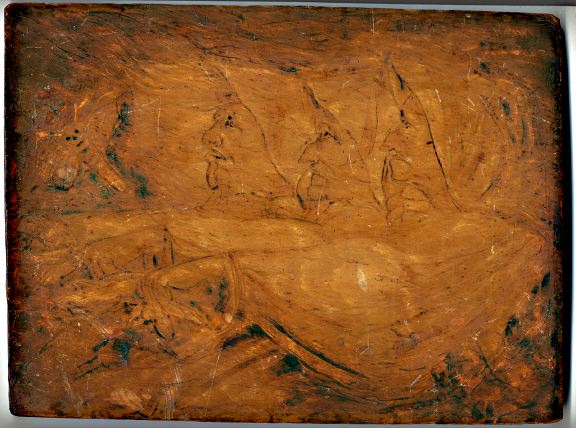 |
| The Witches of MacBeth, By Ball Hughes, Boston, circa 1840 Poker work on unsigned wood panel, 10.5 in. by 8 in. After an 18th C. oil painting by Fuseli Digital image thanks to David and Debbie Plunton |
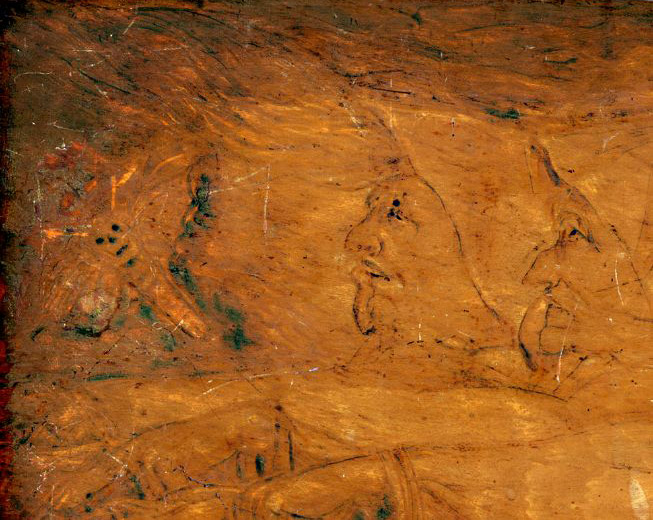 |
| The Witches of MacBeth,detail By Ball Hughes, Boston, circa 1840 Poker work on wood panel, 10.5 in. by 8 in. After an 18th C. oil painting by Fuseli Digital image thanks to David and Debbie Plunton |
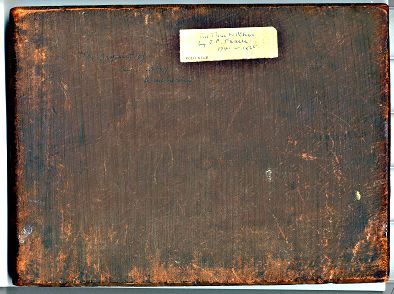 |
| The Witches of MacBeth Handwritten inscription on the back of the panel By Ball Hughes Poker work on wood panel, 10.5 in. by 8 in. Digital image thanks to David and Debbie Plunton |
 |
| The Witches of MacBeth Detail of the inscription on the back of the panel By Ball Hughes, circa 1840 Poker work on wood panel, 10.5 in. by 8 in. Written inscription on the back reads: The Property of A. J. Crosby, Winchester (N.B. A. J. Crosby's first name was Arthur, but he was known to everyone as Jim.) Digital image thanks to David and Debbie Plunton |
FOLLOWING ARE IMAGES OF THE SAME PANEL, NOW PARTIALLY RESTORED:
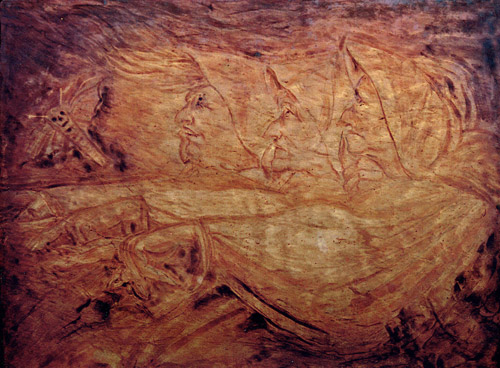 |
| The Witches of MacBeth By Ball Hughes, Boston, circa 1840 Poker work on unsigned wood panel, 10.5 in. by 8 in. After an 18th C. oil painting by Fuseli Digital image by David Plunton, © 2008 |
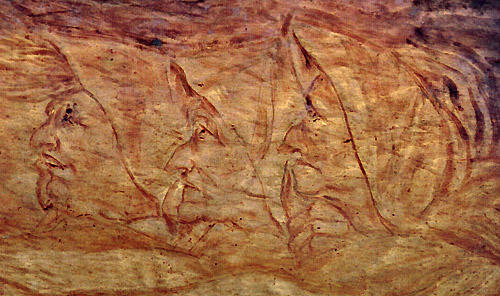 |
| The Witches of MacBeth, detail By Ball Hughes, Boston, circa 1840 Poker work on unsigned wood panel, 10.5 in. by 8 in. After an 18th C. oil painting by Fuseli Digital image by David Plunton, © 2008 |
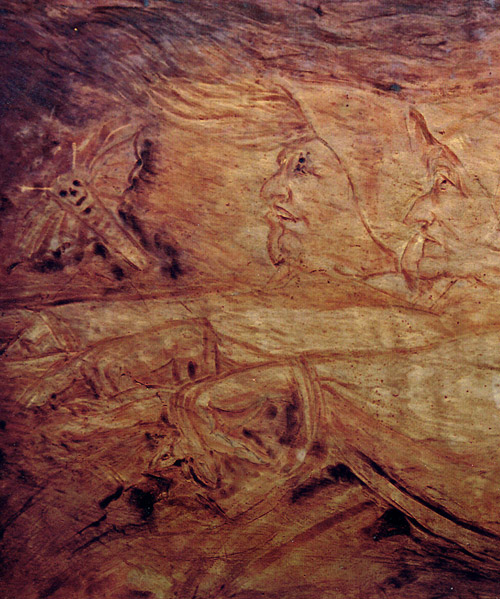 |
| The Witches of MacBeth, detail By Ball Hughes, Boston, circa 1840 Poker work on unsigned wood panel, 10.5 in. by 8 in. After an 18th C. oil painting by Fuseli Digital image by David Plunton, © 2008 |
David Plunton in England acquired the above unsigned piece from a family friend in the early 1990's. It is believed to be a work by 19th century artist Robert Ball Hughes.
This Ball Hughes pyroengraving (also called poker work) of The Witches of MacBeth is featured in Pyrograffiti, published in the July–August 2002 issue of the Woodcarvers Online Magazine (WOM). That article talks about the provenance of this unsigned piece and the Pluntons' quest to ascertain its authenticity. This piece is shown there along with the 18th C. painting The Three Witches by J. H. Fuseli that inspired it, as well as a photograph that appeared to illustrate this very piece for an 1896 article by J. William Fosdick in which he talks about Ball Hughes' contribution to pyrography in America.* The 2002 article links to an earlier Pyrograffiti when the Fosdick article first came to light on the Cornell University website. It revealed for the first time the existence of this Ball Hughes piece.* (The 1896 Fosdick article is now also displayed here in the E-Museum at this link.)
In their quest to learn about their antique wood panel, the Pluntons have sought advice and placed their pyroengraving in the temporary care of British artist and conservator Susan Millis, BA (Hons) Cons & Rest, ARMS, PVPSWA, SEA, MASF, FRSA. Having researched and examined the pyrograph under magnification, Susan is confident that it is an original Ball Hughes even though it is unsigned. Following is her summary of her report:
"The panel shows the signs of age consistent with those of the early to mid-nineteenth century held as part of the Pinto Collection at the Birmingham Museum and Art Gallery in England. During that period in history, the artist would have employed metal tools with nonconductive handles. In America it is written that these were copper [1], in Britain steel [2, p.133]. The tools would have been used in conjunction with a charcoal fire; therefore, there would have been no form of heat control save for the passing of time cooling the points while working. At first glance it seems amazing that such artistically competent works were produced at all, but with passion and patience the practitioners would soon have achieved technical excellence. To hinder them, calx [3] may have formed on the points and, at times, become dislodged, falling onto the surface. The surface 'peppering' [4] over the image of the 'The Witches of MacBeth' suggests that it happened in this case. Gathered clinker would also have caused problems. Under powerful magnification it becomes clear that one or two of these random burns still have fragments embedded in them. The results of my Ball Hughes questionnaire revealed that three other owners have recognised these surface imperfections on their panels.
I have often been asked why many antique pyrographs are not from an original source. In their book Tunbridge and Scottish Souvenir Woodware, Edward and Eva Pinto point out, 'It was doubtless, too, the slowness of the technique, requiring a skilful and detailed drawing on the wood before the hot-point lines could be incised, which led to so much pyrography being a translation of portraits and noted pictures into terms of burnt wood panels [2, p.132].' However, it must be remembered that copying was also fashionable in artistic circles, and it is the ultimate compliment one artist can pay to another."
References and Footnotes
[1] FOSDICK, J. William (1896) "Burnt wood in decoration. With ancient and modern examples,"
found in The Century, Vol. 52, issue 4 (Aug 1896); available from
http://cdl.library.cornell.edu/cgi-bin/moa/moa-cgi?notisid=ABP2287-0052-97
Internet site, accessed on 22.2.2002; p.496.
[2] PINTO, Edward H & PINTO, Eva R (1970) Tunbridge and Scottish Souvenir Woodware, London; G. Bell & Sons.
[3] Calx is the crumbly residual product of an oxidation/reduction reaction that sometimes forms when a metal is heated, especially where wood or charcoal is involved.
[4] In this case, the word 'peppering' is used to describe a series of small, dark, burn marks scattered over the surface.
* UPDATE AS OF JUNE 2008: Since the original Pyrograffiti article about this panel came out in 2002, Susan Millis has studied this work over a significant period of time. Although she authenticated this panel to be an original work by Robert Ball Hughes (as per her report summary above), after expertly removing the varnish and doing further studies under magnification, she eventually arrived at the determination that it is not, however, the work owned by J. William Fosdick and his father before him. That panel—of the same subject—is the one dated 1862 and illustrated in Fosdick's 1896 Century Magazine article on p. 499.
After careful consideration, Susan concluded that the work displayed here is a far earlier work that probably dates from the early 1840's. Further information about her procedure will be forthcoming at a later time. Susan Millis is currently a doctoral candidate working through experimentation and study on the conservation and restoration of pyrographic works. As part of that effort, in the summer of 2006, she made a research trip to the United States specifically to study the works of Ball Hughes. That trip was documented in the July–August issue of Pyrograffiti that year.
Robert Ball Hughes was the sculptor who did the Alexander Hamilton statue that subsequently burned in the fire of 1835. A surviving plaster study of that sculpture is held by the Museum of the City of New York. Ball Hughes also worked as a miniaturist engraver and modified the Gobrecht design of Lady Liberty, which appeared on many U.S. minted coins from 1840 on.
In an 1891 column in The New England Magazine entitled, "The Old Masters of Boston," Samuel L Gerry wrote the following words of praise about the artist:
And now flits across the memory a brilliant sculptor, whose familiar face and tall figure were well known in our streets. Ball Hughes was without controversy a genius, as is evidenced by his well-known group of the Widow Wadman and Uncle Toby, and the fine statue of Bowditch, both I think in the Art Museum. He was cut down in the prime of life, yet not by the hand of death. Many knew him in his later years by his poker drawings, which he did for small returns. It was like "a giant cracking nuts." We have never had in Boston natural powers for art superior to his. In all his obliquities he was a gentleman.
An October 2001 column by Peter J. Stevens in the Boston Neighborhood News entitled
Dorchester's First Couple of the Arts In the 19th Century: Mr. And Mrs. Robert Ball Hughes Put Dorchester on the National Arts Scene offers a vignette of the artist's life.
If you have either any questions to ask or any information to offer regarding this Ball Hughes work or others, please e-mail David Plunton and the E-Museum Curator.
I have often been asked why many antique pyrographs are not from an original source. In their book Tunbridge and Scottish Souvenir Woodware, Edward and Eva Pinto point out, 'It was doubtless, too, the slowness of the technique, requiring a skilful and detailed drawing on the wood before the hot-point lines could be incised, which led to so much pyrography being a translation of portraits and noted pictures into terms of burnt wood panels [2, p.132].' However, it must be remembered that copying was also fashionable in artistic circles, and it is the ultimate compliment one artist can pay to another."
You are leaving the Ball Hughes Salon No. 3.
You can return to the
Antique Hall
or visit one of the following:
Pyrographic Art Exhibit Halls:
Portraits and Paintings
Decorative and Applied Art
Sculpture
Traditional and Folk Art
Children's Pyrographic Art
Special Pyrographic Art
The Book Store and E-Museum Library
Pyrography Tools and Techniques
Your questions and comments are welcome and appreciated.
Please e-mail the E-Museum Curator
Back to E-Museum Entrance homepage
2002, 2003, 2004, 2006, 2008, 2009 Kathleen M. Garvey Menéndez, all rights reserved.
Last updated 7 November 2009.

